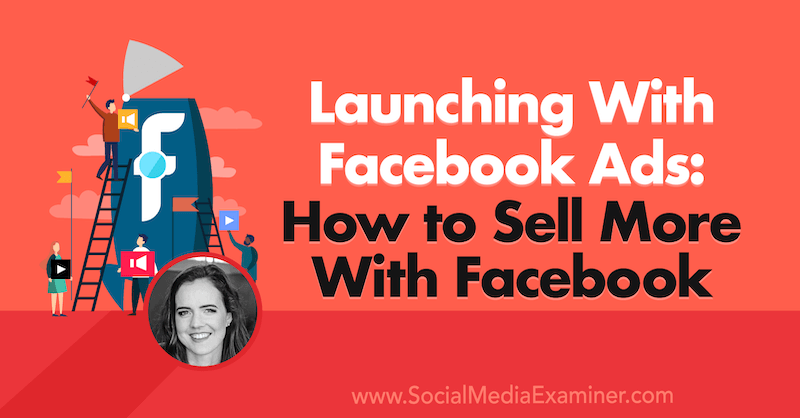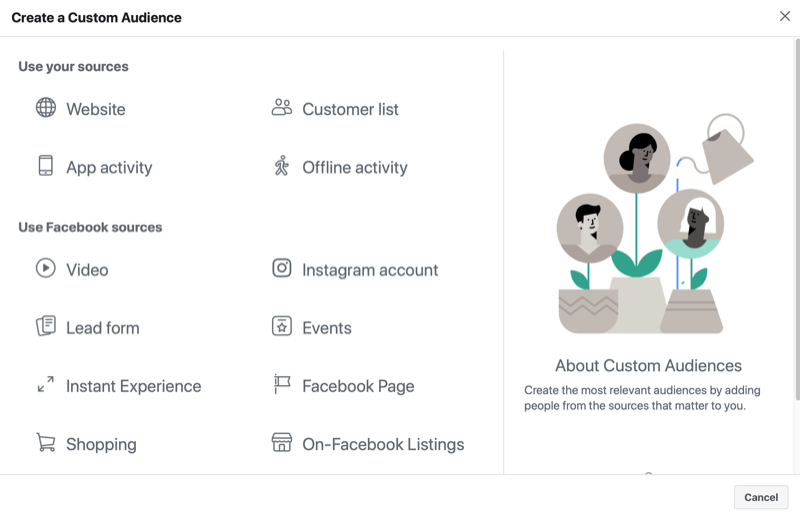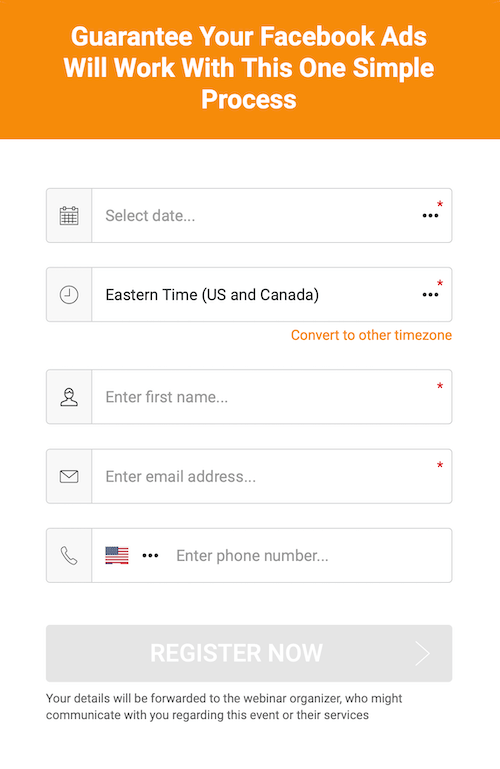Are Facebook ads an important part of your launch strategy? Wondering how you can use Facebook to sell more during your next launch?
To explore how to use Facebook ads to generate more sales during a launch, I interview Emily Hirsh on the Social Media Marketing Podcast.
Emily is the founder of Hirsh Marketing, an ad agency that specializes in helping influencers and coaches sell their digital products. She hosts the Hirsh Marketing Underground podcast and her course is called Ignite: Marketing for Influencers.
You'll learn how the five steps of The Hirsch Process support a successful launch and discover how to apply each step of the process to your own launch. You'll also find examples of Facebook ads to model in your launch.
Listen to the Podcast Now
This article is sourced from the Social Media Marketing Podcast, a top marketing podcast. Listen or subscribe below.
Where to subscribe: Apple Podcasts | Spotify | YouTube Music | YouTube | Amazon Music | RSS

To gain entry to the online world, Emily began her journey as a virtual assistant serving entrepreneurs who sold courses and services. She taught herself how to use everything from ClickFunnels to Infusionsoft to Ontraport, and then Facebook ads.
When she ran ads for a digital summit and secured 10,000 signups at a cost of 50 cents per lead, she realized she had something of value she could take to the next level and have a greater effect on more people.
Over time, she began saying no to anything but work with Facebook ads. Three years ago, when she began building her team, she created The Hirsh Process to teach her team members what she was doing intuitively so they could serve their clients.
Today, Emily has a team of 24 people, a roster of more than 55 clients, and she's overseen several eight-figure launches for several big influencers including Marie Forleo and many others who have appeared on this podcast.
Why Should Marketers Focus on Facebook Ads for a Launch?
While the cost of Facebook ads has definitely gone up in the last 3 years, Emily still believes—and sees data every day to support her belief—that Facebook ads are the most inexpensive advertising choice to reach more of your ideal customer during a launch.
So much work goes into the launch content you put out there to connect with the audience you're after that limiting yourself to organic posts, your email list, or another advertising platform simply isn't sound business practice. Those tactics won't make the splash that Facebook and Instagram ads will.
Emily has tested ads on Google, YouTube, and LinkedIn, and she's found that Facebook and Instagram ads are the cheapest route, due in large part to the fact that most people's ideal audience is on Facebook and Instagram. It's an inexpensive way to reach thousands of more people than you could reach otherwise.
Get World-Class Marketing Training — All Year Long!
Are you facing doubt, uncertainty, or overwhelm? The Social Media Marketing Society can help.
Each month, you’ll receive training from trusted marketing experts, covering everything from AI to organic social marketing. When you join, you’ll also get immediate access to:
- A library of 100+ marketing trainings
- A community of like-minded marketers
- Monthly online community meetups
- Relevant news and trends updates
This holds true for big influencers with large email lists and audiences as well as for smaller influencers who don't yet have those large email lists or audiences.
The Most Common Mistake Made While Advertising a Launch
What you do leading up to a launch and in between launches is sometimes more important than the launch itself, Emily notes.
A typical launch will have multiple components or phases: A pre-launch, a video series, then a webinar, then a challenge, and so on. Each phase of the launch requires certain types of ads and messaging.
One of the biggest mistakes Emily sees people make comes down to a lack of planning and advertising for each of those phases. They'll simply run some general ads to a webinar or video series and hope for the best.
The Hirsh Process involves looking at the sales number for the launch itself and determining how many people need to be on the email list to achieve that sales number. Emily then works the timeline backward from there to figure out how long it should take to build that list up to where it needs to be. Often, Emily will run strategic ads to grow a list for a couple of months before the launch even happens.
The Hirsh Process: A 5-Step Method
The Hirsh Process breaks down into five steps that cover strategy, brand awareness and visibility, lead generation, sales, and scaling and optimization.
Strategize: Pre-Launch Planning
Begin with the three pieces of foundational work you'll need in place before you run ads.
Clear Definition of the Ideal Customer
It's critical that your marketing—your ad copy, your hook, your webinar title, and other items—can go three layers deeper than anybody else's in the news feed. This ensures everything you put out—from free content to lead generation ads—is attracting the right customer because your ultimate goal is to sell what you're offering.
To make sure there's no disconnect in attracting your ideal customer, you must be clear on who they are.
Ask yourself things like what are their biggest frustrations? What is their dream—something they want but don't have? What are their biggest fears? Then, rather than listing those answers at a high level, go deeper and define them in detail. What would they say to their friend if they were standing in line at the coffee shop? How would they describe their frustration in that context vs. a technical or professional context?
To illustrate, someone in the health and wellness space may say, “My customer is someone who wants to test their hormones.” But if that customer was talking to a friend, they would say, “I just want to feel better. I don't want to feel sick anymore and I want to lose weight.”
The words they would use with a friend are the words that need to show up in your marketing.
Emily highly recommends doing interviews with potential ideal customers to get that exact language and then keeping it in a document you can reference when you craft your messaging.
Create the Strategy
After you've identified the ideal customer and the language they use, clearly define every phase of your launch. How long will your launch be? What do the emails look like? How long do you need the nurturing and the pre-launch piece to be?
While you're in this phase, don't make the mistake of trying to replicate another coach's strategy. Instead, take your audience's preferences and behaviors into account. Do they have time to participate in a challenge? Should you do a long webinar? Will your audience sit and watch it? Base your decisions on your customer, not someone else's.
Define Your Budget
If you don't define success before you start running your ads, how will you know if they're successful?
First, you need to set your sales goal. How much money do you want to make and how much product do you need to sell to make that money? Then work backward.
To visualize this, if you know that 2% of leads will convert, figure out how many leads you need to sign up for your webinar and how much you're willing to pay per lead. Then use those numbers to determine your budget.
When you begin running ads, you can then look at your performance and make adjustments. If, for instance, you find that you're converting 3% of your leads, you might decide you're willing to pay up to $7 per lead.
Brand Awareness and Visibility: Organic + 3% to 4% of Ad Budget for Pre-Launch Audience-Building
The next step is one many people get wrong because they rely solely on organic posts. A more effective tactic is to use 3% or 4% of your advertising budget to promote specific organic posts to a cold audience with the goal of growing a warm audience you can retarget in the future.
When you retarget those warmed audiences with ads for your webinar, you're likely to get a cheaper cost per lead and, more importantly, a more valuable lead because they've already consumed your content in some way. You've been able to build trust and credibility with them so they're more likely to buy on that webinar.
Based on the timeline you established in the planning phase, begin this process 1–2 months out from the date of your actual launch.

Discover Proven Marketing Strategies and Tips
Want to go even deeper with your marketing? Check out the Social Media Marketing Podcast! Publishing weekly since 2012, the Social Media Marketing Podcast helps you navigate the constantly changing marketing jungle, with expert interviews from marketing pros.
But don’t let the name fool you. This show is about a lot more than just social media marketing. With over 600 episodes and millions of downloads each year, this show has been a trusted source for marketers for well over a decade.
Emily recommends sticking to posts that feature your main content form. She notes that podcasts and 3- to 5-minute videos seem to perform better because there's a deeper level of connection when you hear someone's voice or see them speak. The key with podcasts is to send people to the show notes page on your website with an embedded play because you need that pixel to fire. You won't be able to retarget someone who listens on Apple podcasts.
You want to get your podcast, videos, or blog posts in front of people who don't know about your brand—or have never come into contact with it—in the hope that they'll consume that valuable content. The key is to make sure the content you promote is strategically chosen to appeal to the ideal customer you defined earlier.
Then you can build warm audience buckets from that traffic to retarget people who have watched a percentage of your videos, visited your website or specific web pages, engaged with your Facebook ad, sent you a DM on Instagram, and so forth.

Lead Generation: 80% to 90% of Ad Budget for Promoting the Top-of-Funnel Experience
This step is where you focus on getting people to register and show up for a free event and making sure you hit the lead goals you determined during the planning of your launch. Allocate 80% to 90% of your ad budgets to promoting this event in a short window of time—usually about a week.
Emily recommends dividing your lead goal by the number of days in your promo window so you know exactly how many leads you need per day. Then you'll know how much you should spend on ads each day and you can schedule your campaigns.
Whether you want people to register for a video series, a webinar, or a challenge, that entire experience should provide a perfect lead-up to your offer.
Carefully consider the type of experience, the title, and the content of the experience. You have to walk a fine line between delivering enough value without giving too much away, and at the same time, make sure the content leads viewers to the conclusion that buying your offer is a no-brainer by the end of the experience.
Emily's standard launch strategy is to nurture audiences with a three-part video series interspersed with Q&As and follow up with the webinar experience.
With regard to lead information you should collect, Emily says an email address works best. That same opt-in box can also feature a field for a phone number. In Emily's experience, about 50% of people will provide their phone number.

Finally, she likes to feature a download incentive such as a workbook on the registration thank-you page that registrants can access by opting into ManyChat. She notes that 50%–60% of people take advantage of this additional opportunity, and she's seen good success with sending live attendees on the webinar a reminder message right when the webinar goes live.
Sales: 5% to 10% of Ad Budget for Retargeting Ads
Your cart should be open for a short window, say 7 days, so incorporating urgency into your messaging and ads at this stage is very important.
Because you're dealing with a smaller audience at this stage, Emily recommends having four to five different ads versus one general sales ad that runs during the 7-day open cart period. You don't want people to see the same ad for 7 days. At the same time, you want to be top of mind so people don't forget that the cart is open and that it will close on X day.
Create and release a mix of ads to overcome all of the different objections people have throughout that 7-day period. The mix of ads you run during this phase might include one that's specific to a bonus that drops in the middle of the open cart period, a general video ad, and testimonial ads. With these in place, you'll be able to layer even deeper retargeting.
For testimonial ads, Emily suggests a carousel ad to feature three or four different customers. You don't want to make it difficult for someone to pull out the important point from each testimonial so choose your components with care. A quote graphic with a colorful background and a circle around the customer's face that includes a powerful quote is very effective. Video also works well as long as you use a short, impactful clip rather than a 5-minute video.
Emily's favorite type of retargeting ad is the abandoned sales page ad. This is especially effective in the digital space when you do a video that opens with you saying, “Hey, I know you were super-close to signing up for this program. You're right on the fence. I know, it's a big decision. Here's why you should sign up …” Then you go on to knock down their objections and close with a reminder that the cart's closing soon.
Emily has seen 1,000% ROI on these ads because you're dealing with a small audience of people who have often made it as far as your checkout page before they abandon the cart. This means the ad budget is small.
Rather than running all of your ads at the same time, Emily suggests you stagger them throughout the open cart period so you have a new ad running every 1–2 days. Watching the frequency score for your ads will help you know when to layer in a new ad.
You could start with the general sales ad and run it for a day or two, a testimonial ad for the next few days, then the bonus ad in the middle of the open cart window. The only ad you run the entire time is the abandoned sales page/cart ad.
Scaling and Optimization
It's true that a lot of the optimizing and scaling happens during any launch. You scale what's working and turn off what's not working. It's also true that the success of a launch comes from what you learn from the last one to help you fix the next one.
That's why this step is focused on comparing the data to the goals that you set in step one and figuring out what worked, what didn't, and what needs to be improved.
To illustrate, what was the actual cost per lead? What was the sales conversion? What was the webinar show-up rate, or the average watch time on your videos? Where did people drop off and stop engaging? Where did you feel like you lost people? What percentage of buyers came from the video series versus the webinar? Should you spend more money on promoting the webinar next time? How long were people on your list before they bought? Where can you shift money away from something that didn't work to something that did work to improve the conversion?
Key Takeaways From This Episode:
- Learn more about Emily Hirsh at hirshmarketing.com.
- Listen to the Hirsh Marketing Underground podcast.
- Check out the monthly Hirsh Marketing Report.
- Explore ManyChat.
- Register for the Google Analytics for Marketers Course at GASuccess.live.
- Watch exclusive content and original videos from Social Media Examiner on YouTube.
- Tune into our weekly Social Media Marketing Talk Show. Watch live on Fridays at 10 AM Pacific on YouTube. Listen to the replay on Apple Podcasts or Google Podcasts.
Help Us Spread the Word! Please let your Twitter followers know about this podcast. Simply click here now to post a tweet.
If you enjoyed this episode of the Social Media Marketing podcast, please head over to Apple Podcasts, leave a rating, write a review, and subscribe.
What do you think? What are your thoughts on using Facebook ads as part of your launch strategy? Please share your comments below.
Attention Agency Owners, Brand Marketers, and Consultants

Introducing the Marketing Agency Show–our newest podcast designed to explore the struggles of agency marketers.
Join show host and agency owner, Brooke Sellas, as she interviews agency marketers and digs deep into their biggest challenges. Explore topics like navigating rough economic times, leveraging AI, service diversification, client acquisition, and much more.
Just pull up your favorite podcast app, search for Marketing Agency Show and start listening. Or click the button below for more information.

